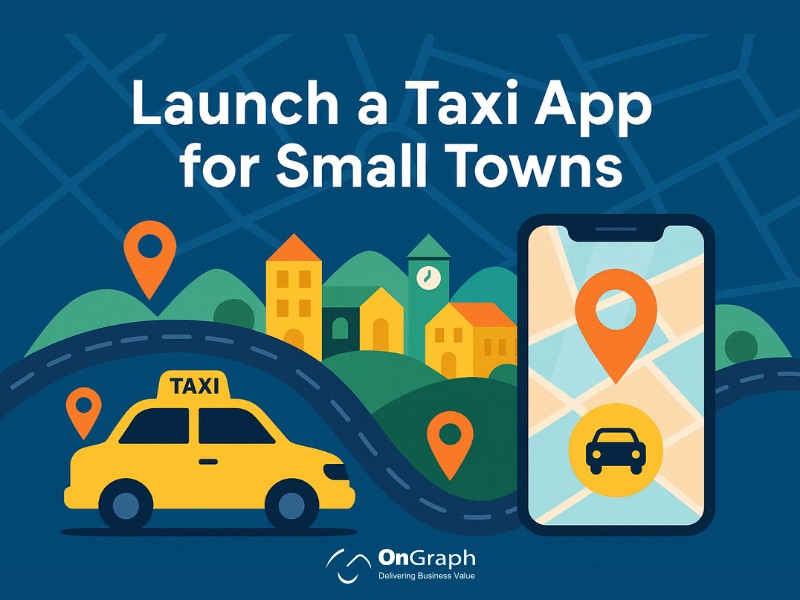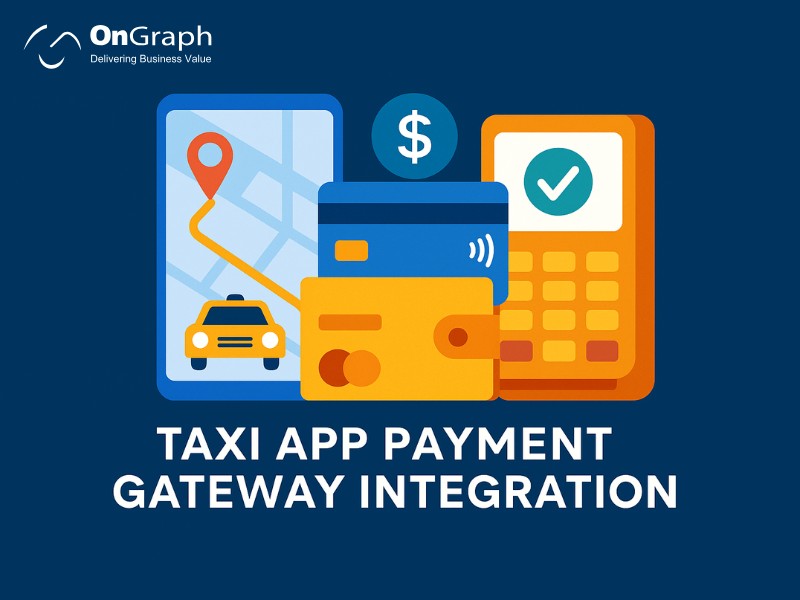In this article
- Why Small Towns Need a Taxi App in 2025
- Understanding the Small-Town Mobility Landscape
- Benefits of Launching a Taxi App for Small Towns
- White Label Taxi App vs Custom Build for Startups
- Taxi App Features Needed for Small Town Markets
- Taxi App Development Cost for Small Town Launch
- Taxi App Deployment Challenges in Small Towns
- A Complete Low-Cost Go-To-Market Strategy for Small Town Taxi Apps
- Case Study: Small Town Deployment Success
- Conclusion
Launching a Taxi App for Small Towns is now a practical and profitable opportunity for local mobility entrepreneurs.
Smartphone adoption is growing fast in rural and semi-urban regions. Digital payments are becoming common even in small markets.
Consumers expect reliable transport options that offer safety, transparency, and predictable pricing. These trends create strong demand for simple and low-cost ride-hailing solution models in small towns.
Today, small fleet owners, independent operators, and local taxi businesses can launch app-based services without spending large budgets.
White-label taxi app solution options allow fast deployment, lower technical risk, and stable operations. This guide explains a complete go-to-market plan for launching a taxi app in a small town.
You will learn how to cut costs, set up operations, and manage early growth with proven strategies.
Why Small Towns Need a Taxi App in 2025
Small towns across the world face similar transport problems. Unpredictable availability, inconsistent pricing, and a lack of professional service limit mobility. These issues push people to look for digital ride-hailing options.
Key reasons demand rise
1. Growing smartphone penetration. Rural smartphone usage crossed 67% in 2024, according to global telecom reports.
2. Cashless adoption. Digital payment users in rural regions grew by more than 30% last year.
3. Tourism growth in small towns. Rural tourism is increasing by 12% year over year.
4. Micro-entrepreneurs entering mobility. Small families and independent drivers want a local taxi business startup model.
5. Customer expectation shift. People now want app-based tracking, fare transparency, and reliability.
A Taxi App for Small Towns solves these pain points with predictable pricing, real-time tracking, and verified drivers.
Understanding the Small-Town Mobility Landscape
Small towns operate differently from major metropolitan areas. The buying behavior, user expectations, and driver availability vary significantly.
Characteristics of small-town markets
- Short travel distances
- Limited vehicle types
- Low competition
- Strong word-of-mouth influence
- Higher trust in local operators
- Lower disposable income among users
- Fewer payment method preferences
- Dependence on repeat bookings
These traits make small towns ideal for a budget-friendly taxi app launch strategy. You can scale steadily using minimal investment and controlled operations.
Benefits of Launching a Taxi App for Small Towns
Launching a digital transport service helps both business owners and the local community.
1. Low competition, high retention
Most small towns do not have organized ride-hailing services. Early movers enjoy strong brand recall.
2. Faster adoption
Customers appreciate predictable pricing and verified drivers. This increases daily bookings.
3. Simple fleet management
A small fleet taxi software setup is enough for early operations.
4. Quick revenue generation
Each trip brings direct income. Operating costs remain low.
5. Strengthens the local economy
Drivers, families, and local partners benefit through stable earnings.
A Taxi App for Small Towns is not only a business but also a community mobility upgrade.
White Label Taxi App vs Custom Build for Startups
Many small-town founders struggle to choose between building from scratch or using a ready platform. Understanding both helps you decide.
Custom Build
- High flexibility
- Unique design and features
- High development cost
- Long delivery timeline
- Requires large technical teams
Best for: Large companies with unique features.
White-Label Taxi App Solution
- Ready in weeks
- Much lower cost
- Stable and tested features
- Branding and theme customization
- Supported by development teams
- Easy to scale later
Best for: Local entrepreneurs who want to launch fast at a low cost.
For Taxi App for Small Towns, a ready-made taxi app solution is usually the ideal choice. It cuts development time and avoids early technical risks.
Also read- White Label Taxi App vs Custom Build for Startups
Taxi App Features Needed for Small Town Markets
Small markets require simple, useful, and essential features. Avoid unnecessary complexity.
Core rider features
- Quick login
- GPS location detection
- Real-time driver tracking
- Fare estimate
- Cash or wallet payments
- SOS button
- Booking history
Core driver features
- Online/offline toggle
- Trip acceptance
- Map navigation
- Earnings dashboard
- Document upload
- Ratings and reviews
Admin panel features
- Fleet management
- Trip assignment
- Area control and geofencing
- Fare setup
- Coupon control
- Driver verification
- Payment settlements
These features ensure smooth and safe operations with minimal training.
Taxi App Development Cost for Small Town Launch
Understanding cost helps shape your GTM plan. Development cost depends on features, platforms, backend systems, and integrations.
Typical cost range
- Custom-built taxi app: $20,000 to $60,000
- White-label solution: $5,000 to $12,000
- Monthly support: $200 to $400
- Server cost: $20 to $60 per month
- Payment gateway cost: Per-transaction fees
A budget friendly taxi app launch using white-label solutions minimizes risk. You avoid technical delays and speed up market entry.
Also read- Taxi App Development Cost in 2025: Full Budget Guide
Taxi App Deployment Challenges in Small Towns
Small-town launches bring unique challenges. Preparing early helps increase success rates.
1. Low digital awareness
Some users may prefer phone-based bookings.
2. Payment limitations
Many small towns depend on cash payments.
3. Limited driver availability
Recruiting drivers requires trust-building campaigns.
4. Patchy internet
Apps must support low-network conditions.
5. Seasonal demand fluctuations
Tourist seasons bring spikes in demand.
A strong Taxi App Development Company can solve most of these issues through optimization, offline features, and efficient driver onboarding.
A Complete Low-Cost Go-To-Market Strategy for Small Town Taxi Apps
This section provides a practical GTM strategy for launching a Taxi App for Small Towns successfully.
1. Start with a Small Fleet
Begin with 5 to 20 vehicles. It reduces complexity and cost.
Benefits
- Lower operational risk
- Better monitoring
- Stronger quality control
- Higher service consistency
This aligns perfectly with small fleet taxi software operations.
2. Use Local Drivers with a Strong Reputation
Small towns operate on trust. Local customers prefer familiar drivers. Focus on onboarding drivers who understand local routes.
3. Set Simple Pricing
Customers like transparent pricing. Avoid dynamic pricing in early stages.
Pricing tips
- Set base fare
- Add per-kilometer charges
- Add minimal waiting charges
- Use round numbers
This builds trust and increases repeat bookings.
4. Create a Simple Marketing Plan
Use simple and low-budget marketing approaches that work best in small towns.
Effective channels
- Local Facebook groups
- WhatsApp broadcast lists
- Flyers at bus stands
- Partnerships with local shops
- Posters in schools and clinics
- Local influencers
- Auto-rickshaw stickers
Word-of-mouth grows fast in close-knit communities.
5. Offer Strong Customer Support
Small-town customers expect personal support. Provide a local phone number to handle complaints, lost items, and booking issues.
6. Build a Local Brand Identity
A simple logo, consistent color theme, and your town’s name in the brand increase trust instantly.
7. Use a Ready-Made Taxi App Solution
Speed matters. A ready-made taxi app solution lets you launch in 10 to 21 days. It reduces cost, improves reliability, and prevents technical delays.
8. Expand Gradually to Nearby Villages
Once demand stabilizes, expand to nearby rural zones. Rural area ride sharing can bring new revenue streams and fill mobility gaps.
Case Study: Small Town Deployment Success
A small transport operator in a semi-urban town launched a taxi app using a white-label platform. They started with 10 cars.
Results after six months
- 42% increase in bookings
- 55% repeat customers
- 33% increase in income for drivers
- 70% reduction in phone-based booking time
- Expanded to two nearby towns
This shows the revenue potential of a Taxi App for Small Towns.
Conclusion
Launching a Taxi App for Small Towns is a smart opportunity for 2025. Small towns need reliable mobility options. Digital adoption is rising, and competition is low.
A simple, well-planned strategy and a white-label taxi app solution can help you launch quickly and affordably.
With a small fleet, local drivers, transparent pricing, and strong customer support, your business can scale sustainably across rural and semi-urban regions.
FAQs
Yes. Small towns have low competition. You can launch with a small fleet and earn steady revenue from daily bookings.
Use a ready-made taxi app solution. It cuts development time and reduces early technical expenses.
You can begin with five to ten vehicles. This supports stable operations without high cost.
Use WhatsApp, flyers, local influencers, and partnerships with shops. Small towns rely on word-of-mouth.
GPS tracking, fare estimate, driver verification, earnings dashboard, admin panel, and SOS are key Taxi App Features.
White-label apps can be deployed in 10 to 21 days. Custom apps take months.
Limited digital literacy, low network areas, and driver onboarding issues are common Taxi App Deployment Challenges.
About the Author
Let’s Create Something Great Together!
Latest Blog















